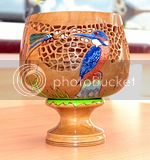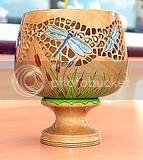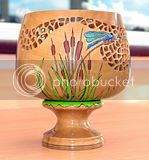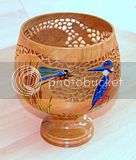You are using an out of date browser. It may not display this or other websites correctly.
You should upgrade or use an alternative browser.
You should upgrade or use an alternative browser.
A Goblet with a difference.
- Thread starter John. B
- Start date

Help Support UKworkshop.co.uk:
This site may earn a commission from merchant affiliate
links, including eBay, Amazon, and others.
John. B
Established Member
The Tulip flower, is a Eurasian & North African genus of perennial, bulbous plants in the lily family.
Tulip wood (Dalbergia decipularis) comes from a tree in North-eastern Brazil, which grows to 20-30 ft high but a trunk of less than 1 ft in diameter
I know, cos I'm a clever clogs. :-" :-" \ / \
/ \ /
/
John. B
Tulip wood (Dalbergia decipularis) comes from a tree in North-eastern Brazil, which grows to 20-30 ft high but a trunk of less than 1 ft in diameter
I know, cos I'm a clever clogs. :-" :-" \
John. B
LancsRick
Established Member
One of the nicest things I've ever seen if I'm honest - any interest in sharing what's involved?

£16.59
£25.00
Woodworking Joinery by Hand: Innovative Techniques Using Japanese Saws and Jigs
Amazon.co.uk

£19.99
Respirator Mask,Safety Dust Face Cover,Dust Face Cover Paint Face Cover,Gas Mask With Filter,For Paint,Dust And Formaldehyde,Sanding,Polishing,Spraying And Other Work
ShenZHEN CIRY MINGYANG LITIAN ELECTRONIC ECOMMERCE

£238.91
£360.17
Trend Portable Benchtop Router Table with Robust Construction for Workshop & Site Use, 240V, CRT/MK3
Amazon.co.uk

£12.50 (£1,250.00 / kg)
£14.45 (£1,445.00 / kg)
JSP M632 FFP3moulded Disposable Dustmask (Box of 10) One Size suitable for Construction, DIY, Industrial, Sanding, dust protection 99 Percent particle filtration Conforms and Complies to EN 149
Amazon.co.uk

£17.99 (£1.80 / count)
£27.44 (£2.74 / count)
3M 8822 Disposable-fine dust mask FFP2 (10-pack)
Amazon.co.uk

£24.99
Facemoon Reusable Masks,Safety Masks,Dual Filter Masks, Paint, Dust, Epoxy Resin, Construction, Welding, Sanding, Woodworking, Chemical Reusable Gas Masks
ShenZHEN CIRY MINGYANG LITIAN ELECTRONIC ECOMMERCE
donwatson
Established Member
Superb workmanship there. Thanks for showing.
John. B
Established Member
Thank you Gents,
Rick for you,
I Started with a large block of tulip I've had for a long time, wondering what to do with it. Started with cutting off one end for the base, put to one side.
Turned a substantial spigot on the remaining block cos it was a big lump. formed the outside shape, drilled into the centre with a forstner just above where I wanted the bottom to be. Bowl gouge taking most of the inside, finishing off to about 2.5 mm wall thickness with a hollowing tool. Put that aside and turned the base hollow for the bowl spigot to fit finishing both with a Hope pro sander, finishing with two or three coats of sanding sealer denibbed between coats. I like to decorate with birds and insects because of the enormous choice that there is and in this case, decided on a Kingfisher with Dragonflies in bullrushes. I use google images to get the right shape and correct colouring of the bird and insect and design where they be relating to the piercing. In this case I wanted the piercing to flow in a wave instead of a wide band around the bowl. I draw the outline of the bird, insect and each of the pierced holes with a soft pencil (H) and follow that with a pyrograph pen The unit I use is a Peter Child Pyro machine (I've had it for over 15 years) but the 'pen' or handpiece I use is an American one by Colwood. The tips of the Colwood are like sharp blades, rather like the burnmaster types, anyway, I burn all the outlines which both defines where to finish the paint line and to prevent paint or finish to 'bleed' across the line. Next, to pierce the holes. For this I use a 'Woodworks Super NP3 Micro motor rotary carver'. I have over time collected a good number of carving bits, a good number I might add from China. This is the bit that's a bit boring because you do not want to go through the wall of an adjoining hole. Next the painting, I used in this case Humbrol enamel for the Kingfisher and bulrushes and Jo Sonja iridescent paints for the dragonflies. (makes them glisten) Glue the bowl to the finished base and spray with clear lacquer and the job is done.
John. B
Rick for you,
I Started with a large block of tulip I've had for a long time, wondering what to do with it. Started with cutting off one end for the base, put to one side.
Turned a substantial spigot on the remaining block cos it was a big lump. formed the outside shape, drilled into the centre with a forstner just above where I wanted the bottom to be. Bowl gouge taking most of the inside, finishing off to about 2.5 mm wall thickness with a hollowing tool. Put that aside and turned the base hollow for the bowl spigot to fit finishing both with a Hope pro sander, finishing with two or three coats of sanding sealer denibbed between coats. I like to decorate with birds and insects because of the enormous choice that there is and in this case, decided on a Kingfisher with Dragonflies in bullrushes. I use google images to get the right shape and correct colouring of the bird and insect and design where they be relating to the piercing. In this case I wanted the piercing to flow in a wave instead of a wide band around the bowl. I draw the outline of the bird, insect and each of the pierced holes with a soft pencil (H) and follow that with a pyrograph pen The unit I use is a Peter Child Pyro machine (I've had it for over 15 years) but the 'pen' or handpiece I use is an American one by Colwood. The tips of the Colwood are like sharp blades, rather like the burnmaster types, anyway, I burn all the outlines which both defines where to finish the paint line and to prevent paint or finish to 'bleed' across the line. Next, to pierce the holes. For this I use a 'Woodworks Super NP3 Micro motor rotary carver'. I have over time collected a good number of carving bits, a good number I might add from China. This is the bit that's a bit boring because you do not want to go through the wall of an adjoining hole. Next the painting, I used in this case Humbrol enamel for the Kingfisher and bulrushes and Jo Sonja iridescent paints for the dragonflies. (makes them glisten) Glue the bowl to the finished base and spray with clear lacquer and the job is done.
John. B
LancsRick
Established Member
Very interesting, thanks for taking the time to write that 
Woodmonkey
Established Member
Sorry john but no, tulip wood comes from the tulip tree liriodendron tulipifera (spelling might be wrong)John. B":1t4gkhez said:The Tulip flower, is a Eurasian & North African genus of perennial, bulbous plants in the lily family.
Tulip wood (Dalbergia decipularis) comes from a tree in North-eastern Brazil, which grows to 20-30 ft high but a trunk of less than 1 ft in diameter
I know, cos I'm a clever clogs. :-" :-" \/ \
/
John. B
Great looking goblet by the way, nice work, that looks like a few hours work
John. B
Established Member
I suppose it always depends from where one gets their information.
mine usually comes from 'The Wood Database' from which the two following descriptions are from. (which I suppose could be wrong).
Tulipwood.
Tulipwood (Dalbergia decipularis) Common Name(s): Tulipwood Scientific Name: Dalbergia decipularis (also Dalbergia frutescens) Distribution: Northeastern Brazil Tree Size: 20-30 ft (6-9 m) tall, less than 1 ft (.3 m) trunk diameter Average Dried Weight: 60 lbs/ft3 (970 kg/m3) Specific Gravity (Basic, 12% MC): .88, .97 Janka Hardness: 2,500 lbf (11,120 N) Modulus of Rupture: No data available Elastic Modulus: No data available Crushing...
Poplar, Cottonwood, and Aspen: What’s What?
by Eric Meier In the United States, the term “Poplar” almost always refers to a specific wood species: Liriodendron tulipifera. Other common names for this wood include Yellow Poplar, American Tulipwood, or Tulip Poplar. The only problem with referring to this species as “Poplar” is that it isn’t actually a type of poplar. That title properly belongs to a genus of trees appropriately named Populus. Types of Poplar...
John. B
BTW I've just noticed we are still on GMT do we not change to summertime?
mine usually comes from 'The Wood Database' from which the two following descriptions are from. (which I suppose could be wrong).
Tulipwood.
Tulipwood (Dalbergia decipularis) Common Name(s): Tulipwood Scientific Name: Dalbergia decipularis (also Dalbergia frutescens) Distribution: Northeastern Brazil Tree Size: 20-30 ft (6-9 m) tall, less than 1 ft (.3 m) trunk diameter Average Dried Weight: 60 lbs/ft3 (970 kg/m3) Specific Gravity (Basic, 12% MC): .88, .97 Janka Hardness: 2,500 lbf (11,120 N) Modulus of Rupture: No data available Elastic Modulus: No data available Crushing...
Poplar, Cottonwood, and Aspen: What’s What?
by Eric Meier In the United States, the term “Poplar” almost always refers to a specific wood species: Liriodendron tulipifera. Other common names for this wood include Yellow Poplar, American Tulipwood, or Tulip Poplar. The only problem with referring to this species as “Poplar” is that it isn’t actually a type of poplar. That title properly belongs to a genus of trees appropriately named Populus. Types of Poplar...
John. B
BTW I've just noticed we are still on GMT do we not change to summertime?
Similar threads
- Replies
- 14
- Views
- 990
- Replies
- 14
- Views
- 2K
- Replies
- 33
- Views
- 4K






























